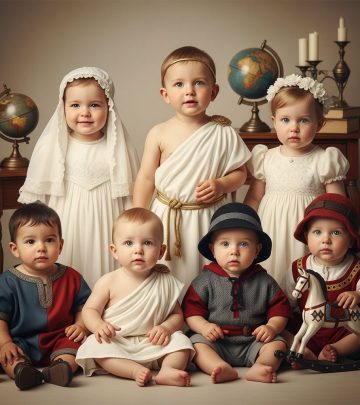Understanding Fraternal Twins: Genetics, Differences, and Surprising Facts
Discover the science, genetics, and unique family dynamics behind fraternal twins, plus how they differ from identical twins.

Fraternal Twins: A Fascinating Overview
Twins spark curiosity in everyone, from new parents to medical experts. While all twins are remarkable, fraternal twins stand out due to their unique conception and development. This article dives into what defines fraternal twins, how they form, their genetic differences from identical twins, and what factors make some families more likely to welcome these sibling pairs.
What Are Fraternal Twins?
Fraternal twins, also known as dizygotic twins, are twins that develop from two separate eggs fertilized by two different sperm. Unlike identical (monozygotic) twins, who share all their genes, fraternal twins share about 50 percent of their DNA, the same as any other siblings born at different times.
Key points about fraternal twins:
- They can be the same sex or different sexes.
- They may look quite different or resemble each other closely, just like regular siblings.
- Each twin has their own placenta and amniotic sac.
Fraternal twins are much more common than identical twins, making up about two-thirds of all naturally occurring twin births worldwide.
How Are Fraternal Twins Conceived?
The conception of fraternal twins is different from that of identical twins. During a typical menstrual cycle, a woman releases one egg. However, in the case of fraternal twins, the mother releases two (or sometimes more) eggs in a process known as hyperovulation. If both eggs are fertilized by different sperm, two genetically unique embryos start to develop side by side.
This means that fraternal twins share their mother’s womb at the same time but are as genetically similar as other brothers and sisters.
- Timing: Both eggs must be fertilized in the same cycle.
- Placenta and Sacs: Each twin generally has a separate placenta and amniotic sac, reducing some risks commonly seen in identical twins.
Fraternal Twins vs. Identical Twins: What Sets Them Apart?
| Feature | Fraternal (Dizygotic) | Identical (Monozygotic) |
|---|---|---|
| Number of Eggs Fertilized | 2 | 1 |
| Number of Sperm | 2 | 1 |
| Genetic Similarity | About 50% (like regular siblings) | Nearly 100% (same DNA) |
| Sex of Twins | Same or different | Always the same |
| Placenta/Amniotic Sac | Usually separate | Shared or separate, depending on timing of embryo split |
| Physical Resemblance | Varies widely | Usually very similar |
| Runs in Families? | Yes (maternal side) | No |
Are Fraternal Twins Genetically the Same?
Unlike identical twins, who develop from the same fertilized egg and share all their genes, fraternal twins are the result of two eggs and two sperm. These twins share about 50 percent of their DNA, just like any pair of siblings. This explains why fraternal twins can look very different from each other, even having different eye colors, hair types, or heights.
Fraternal twins may appear very similar, but this is coincidental. Being born at the same time does not make them more genetically alike than any two siblings.
Can Fraternal Twins Be Different Sexes?
Yes, fraternal twins can be a boy and a girl, two boys, or two girls. This happens because two separate eggs are fertilized by two separate sperm, which determine the sex of each twin independently. In contrast, identical twins are always the same sex because they come from the same fertilized egg, whose sex was determined at conception.
A girl/boy pair of twins is always fraternal.
Why Do Fraternal Twins Run in Families?
A fascinating fact about fraternal twins is that their occurrence tends to cluster in certain families. This is mainly because the trait for hyperovulation—the release of more than one egg during ovulation—can be inherited, but only on the maternal side. If a woman’s mother or grandmother released multiple eggs during ovulation, she is more likely to do the same, increasing the odds of having fraternal twins herself.
- Father’s genetics do not cause fraternal twins: Only a woman releases eggs, so the father’s side doesn’t directly influence fraternal twinning rates.
- Identical twins do not run in families: Their occurrence is random and unrelated to heredity.
External factors, such as age, ethnic background, and even certain fertility treatments, can also increase a woman’s chance of having fraternal twins.
Other Factors That Increase the Chances of Fraternal Twins
- Age: Women over 30, especially in their late 30s, are likelier to release multiple eggs in a single cycle, upping the odds of fraternal twinning.
- Ethnicity: Some populations have naturally higher rates of fraternal twinning. For example, women of African descent are more likely to have fraternal twins than women of Asian descent.
- Fertility treatments: Medications or procedures designed to stimulate ovulation can dramatically increase the chances of conceiving fraternal twins.
- Diet and Body Type: Some studies show that taller, heavier women are more likely to have fraternal twins.
- Breastfeeding: Women who conceive while breastfeeding slightly increase the odds of fraternal twins, though the reasons are not fully understood.
What to Expect During a Fraternal Twin Pregnancy
A pregnancy with fraternal twins is usually diagnosed in the first trimester during an ultrasound scan. Each fetus generally has its own placenta and amniotic sac, which lowers certain risks associated with twin pregnancies, such as twin-to-twin transfusion syndrome (TTTS), a condition seen mostly in identical twin pairs sharing a placenta.
Pregnant women expecting fraternal twins should be prepared for:
- Regular prenatal visits and extra monitoring
- Higher nutritional and caloric needs
- Increased risk of preterm birth and low birth weight
- Potential for delivery via C-section, depending on fetal positions and pregnancy progress
How Similar Are Fraternal Twins in Appearance and Personality?
Fraternal twins can range from looking nearly identical to not resembling each other at all. It’s not unusual for one twin to have blue eyes and the other brown, or for one to have curly hair and the other straight. Their personalities may also be quite distinct—they might share interests or be complete opposites.
This contrast arises because:
- They inherit a different mix of genes from their parents.
- The influence of the environment (nature and nurture) shapes their personalities over time.
Common Myths and Misconceptions About Fraternal Twins
- “All twins are identical.”
Fraternal twins are actually more common than identical twins. - “Fraternal twins skip a generation.”
There is no scientific evidence that fraternal twins skip generations. The tendency comes from inheriting the gene for hyperovulation. - “Twins have a secret language.”
Many twins, particularly those closely bonded, may develop private ways of communicating, but this happens among both fraternal and identical pairs and is not unique to twins. - “Fraternal twins look nothing alike.”
Some fraternal twins look very similar; others do not, just like any siblings born at different times.
Nature vs. Nurture: Are Differences Due to Genetics or Environment?
The old debate of “nature versus nurture” often comes up with twins. With fraternal twins, there is a clear genetic difference (nature), but their shared upbringing (nurture) can produce many shared traits and experiences. Research has shown that while genetics play a significant role in physical traits and can influence personality, environment, and upbringing also have a powerful impact.
Fraternal twins, like all siblings, are unique individuals shaped by a combination of biology and life experiences.
Do Fraternal Twins Have a Special Bond?
Growing up side by side, fraternal twins often develop a deep and lasting connection. While their genetic similarity matches that of regular siblings, their shared experiences—simultaneous milestones, joint classrooms, and common friends—can foster an especially close relationship.
Still, as with all siblings, the strength of their bond depends on their personalities, family dynamics, and life circumstances.
Challenges and Rewards of Raising Fraternal Twins
Parenting twin siblings is uniquely rewarding, but it brings special challenges. These include synchronizing schedules, encouraging individual identities, and meeting the diverse needs of two children with potentially very different personalities and abilities.
- Encourage individuality: Give each child space to explore their own interests and identities.
- Foster their bond: Encourage teamwork, problem-solving, and shared activities, but avoid comparisons.
- Multitask effectively: Master the art of planning and organization to meet both twins’ needs.
Frequently Asked Questions About Fraternal Twins
Q: Can fraternal twins have different fathers?
A: It is rare, but possible. This phenomenon is called superfecundation, where two eggs are fertilized by sperm from different men during the same ovulatory cycle.
Q: Are fraternal twins more likely if you use fertility treatments?
A: Yes. Certain fertility treatments stimulate the ovaries to release multiple eggs, making fraternal twins more common.
Q: Are boy/girl twins always fraternal?
A: Yes. Opposite sex twins (boy and girl) result from two different eggs being fertilized by two different sperm and are, by definition, fraternal.
Q: Do fraternal twins share the same birthday?
A: Most are born on the same day, but there are rare cases where twins are born hours or even days apart, especially if one delivers prematurely.
Q: Can you tell fraternal twins apart before birth?
A: Yes. Ultrasound can often show if there are two placentas and amniotic sacs, which usually means fraternal twins.
Conclusion: Celebrating the Uniqueness of Fraternal Twins
Fraternal twins are a fascinating showcase of nature’s variety and the complexity of genetics. Their individuality is every bit as special as their bond, and their presence often sparks joy and curiosity in families and communities alike. Welcoming fraternal twins means embracing differences, celebrating similarities, and cherishing a one-of-a-kind twin journey.












